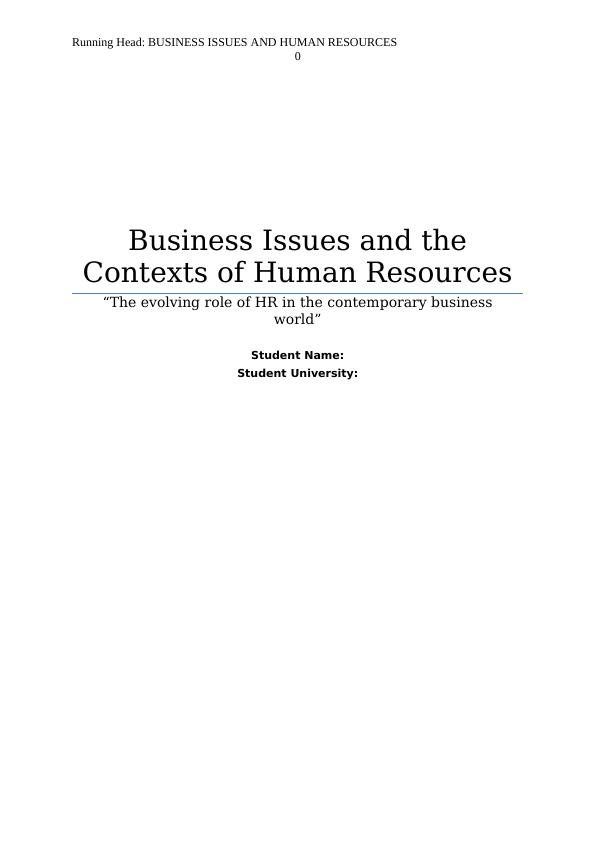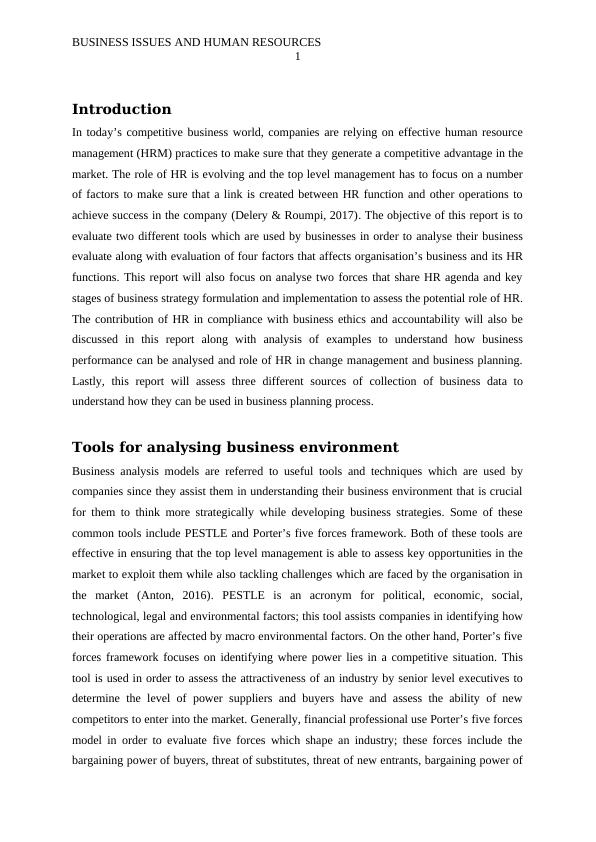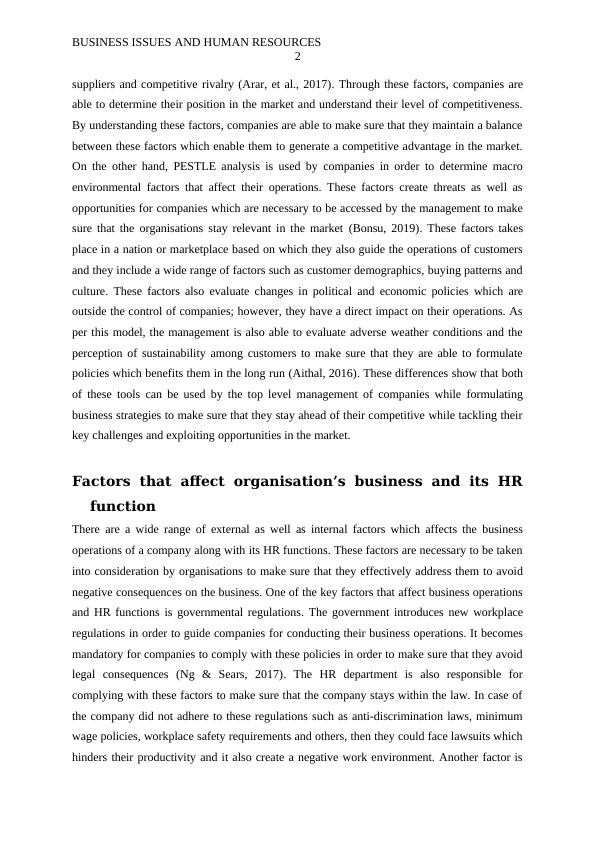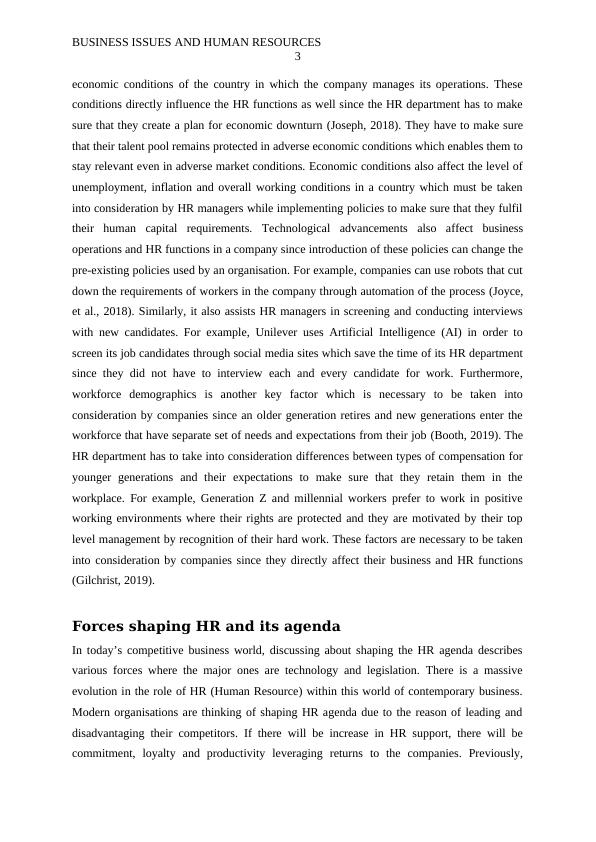BUSINESS ISSUES AND HUMAN RESOURCES
Added on 2022-08-23
16 Pages5591 Words23 Views
Running Head: BUSINESS ISSUES AND HUMAN RESOURCES
0
Business Issues and the
Contexts of Human Resources
“The evolving role of HR in the contemporary business
world”
Student Name:
Student University:
0
Business Issues and the
Contexts of Human Resources
“The evolving role of HR in the contemporary business
world”
Student Name:
Student University:

BUSINESS ISSUES AND HUMAN RESOURCES
1
Introduction
In today’s competitive business world, companies are relying on effective human resource
management (HRM) practices to make sure that they generate a competitive advantage in the
market. The role of HR is evolving and the top level management has to focus on a number
of factors to make sure that a link is created between HR function and other operations to
achieve success in the company (Delery & Roumpi, 2017). The objective of this report is to
evaluate two different tools which are used by businesses in order to analyse their business
evaluate along with evaluation of four factors that affects organisation’s business and its HR
functions. This report will also focus on analyse two forces that share HR agenda and key
stages of business strategy formulation and implementation to assess the potential role of HR.
The contribution of HR in compliance with business ethics and accountability will also be
discussed in this report along with analysis of examples to understand how business
performance can be analysed and role of HR in change management and business planning.
Lastly, this report will assess three different sources of collection of business data to
understand how they can be used in business planning process.
Tools for analysing business environment
Business analysis models are referred to useful tools and techniques which are used by
companies since they assist them in understanding their business environment that is crucial
for them to think more strategically while developing business strategies. Some of these
common tools include PESTLE and Porter’s five forces framework. Both of these tools are
effective in ensuring that the top level management is able to assess key opportunities in the
market to exploit them while also tackling challenges which are faced by the organisation in
the market (Anton, 2016). PESTLE is an acronym for political, economic, social,
technological, legal and environmental factors; this tool assists companies in identifying how
their operations are affected by macro environmental factors. On the other hand, Porter’s five
forces framework focuses on identifying where power lies in a competitive situation. This
tool is used in order to assess the attractiveness of an industry by senior level executives to
determine the level of power suppliers and buyers have and assess the ability of new
competitors to enter into the market. Generally, financial professional use Porter’s five forces
model in order to evaluate five forces which shape an industry; these forces include the
bargaining power of buyers, threat of substitutes, threat of new entrants, bargaining power of
1
Introduction
In today’s competitive business world, companies are relying on effective human resource
management (HRM) practices to make sure that they generate a competitive advantage in the
market. The role of HR is evolving and the top level management has to focus on a number
of factors to make sure that a link is created between HR function and other operations to
achieve success in the company (Delery & Roumpi, 2017). The objective of this report is to
evaluate two different tools which are used by businesses in order to analyse their business
evaluate along with evaluation of four factors that affects organisation’s business and its HR
functions. This report will also focus on analyse two forces that share HR agenda and key
stages of business strategy formulation and implementation to assess the potential role of HR.
The contribution of HR in compliance with business ethics and accountability will also be
discussed in this report along with analysis of examples to understand how business
performance can be analysed and role of HR in change management and business planning.
Lastly, this report will assess three different sources of collection of business data to
understand how they can be used in business planning process.
Tools for analysing business environment
Business analysis models are referred to useful tools and techniques which are used by
companies since they assist them in understanding their business environment that is crucial
for them to think more strategically while developing business strategies. Some of these
common tools include PESTLE and Porter’s five forces framework. Both of these tools are
effective in ensuring that the top level management is able to assess key opportunities in the
market to exploit them while also tackling challenges which are faced by the organisation in
the market (Anton, 2016). PESTLE is an acronym for political, economic, social,
technological, legal and environmental factors; this tool assists companies in identifying how
their operations are affected by macro environmental factors. On the other hand, Porter’s five
forces framework focuses on identifying where power lies in a competitive situation. This
tool is used in order to assess the attractiveness of an industry by senior level executives to
determine the level of power suppliers and buyers have and assess the ability of new
competitors to enter into the market. Generally, financial professional use Porter’s five forces
model in order to evaluate five forces which shape an industry; these forces include the
bargaining power of buyers, threat of substitutes, threat of new entrants, bargaining power of

BUSINESS ISSUES AND HUMAN RESOURCES
2
suppliers and competitive rivalry (Arar, et al., 2017). Through these factors, companies are
able to determine their position in the market and understand their level of competitiveness.
By understanding these factors, companies are able to make sure that they maintain a balance
between these factors which enable them to generate a competitive advantage in the market.
On the other hand, PESTLE analysis is used by companies in order to determine macro
environmental factors that affect their operations. These factors create threats as well as
opportunities for companies which are necessary to be accessed by the management to make
sure that the organisations stay relevant in the market (Bonsu, 2019). These factors takes
place in a nation or marketplace based on which they also guide the operations of customers
and they include a wide range of factors such as customer demographics, buying patterns and
culture. These factors also evaluate changes in political and economic policies which are
outside the control of companies; however, they have a direct impact on their operations. As
per this model, the management is also able to evaluate adverse weather conditions and the
perception of sustainability among customers to make sure that they are able to formulate
policies which benefits them in the long run (Aithal, 2016). These differences show that both
of these tools can be used by the top level management of companies while formulating
business strategies to make sure that they stay ahead of their competitive while tackling their
key challenges and exploiting opportunities in the market.
Factors that affect organisation’s business and its HR
function
There are a wide range of external as well as internal factors which affects the business
operations of a company along with its HR functions. These factors are necessary to be taken
into consideration by organisations to make sure that they effectively address them to avoid
negative consequences on the business. One of the key factors that affect business operations
and HR functions is governmental regulations. The government introduces new workplace
regulations in order to guide companies for conducting their business operations. It becomes
mandatory for companies to comply with these policies in order to make sure that they avoid
legal consequences (Ng & Sears, 2017). The HR department is also responsible for
complying with these factors to make sure that the company stays within the law. In case of
the company did not adhere to these regulations such as anti-discrimination laws, minimum
wage policies, workplace safety requirements and others, then they could face lawsuits which
hinders their productivity and it also create a negative work environment. Another factor is
2
suppliers and competitive rivalry (Arar, et al., 2017). Through these factors, companies are
able to determine their position in the market and understand their level of competitiveness.
By understanding these factors, companies are able to make sure that they maintain a balance
between these factors which enable them to generate a competitive advantage in the market.
On the other hand, PESTLE analysis is used by companies in order to determine macro
environmental factors that affect their operations. These factors create threats as well as
opportunities for companies which are necessary to be accessed by the management to make
sure that the organisations stay relevant in the market (Bonsu, 2019). These factors takes
place in a nation or marketplace based on which they also guide the operations of customers
and they include a wide range of factors such as customer demographics, buying patterns and
culture. These factors also evaluate changes in political and economic policies which are
outside the control of companies; however, they have a direct impact on their operations. As
per this model, the management is also able to evaluate adverse weather conditions and the
perception of sustainability among customers to make sure that they are able to formulate
policies which benefits them in the long run (Aithal, 2016). These differences show that both
of these tools can be used by the top level management of companies while formulating
business strategies to make sure that they stay ahead of their competitive while tackling their
key challenges and exploiting opportunities in the market.
Factors that affect organisation’s business and its HR
function
There are a wide range of external as well as internal factors which affects the business
operations of a company along with its HR functions. These factors are necessary to be taken
into consideration by organisations to make sure that they effectively address them to avoid
negative consequences on the business. One of the key factors that affect business operations
and HR functions is governmental regulations. The government introduces new workplace
regulations in order to guide companies for conducting their business operations. It becomes
mandatory for companies to comply with these policies in order to make sure that they avoid
legal consequences (Ng & Sears, 2017). The HR department is also responsible for
complying with these factors to make sure that the company stays within the law. In case of
the company did not adhere to these regulations such as anti-discrimination laws, minimum
wage policies, workplace safety requirements and others, then they could face lawsuits which
hinders their productivity and it also create a negative work environment. Another factor is

BUSINESS ISSUES AND HUMAN RESOURCES
3
economic conditions of the country in which the company manages its operations. These
conditions directly influence the HR functions as well since the HR department has to make
sure that they create a plan for economic downturn (Joseph, 2018). They have to make sure
that their talent pool remains protected in adverse economic conditions which enables them to
stay relevant even in adverse market conditions. Economic conditions also affect the level of
unemployment, inflation and overall working conditions in a country which must be taken
into consideration by HR managers while implementing policies to make sure that they fulfil
their human capital requirements. Technological advancements also affect business
operations and HR functions in a company since introduction of these policies can change the
pre-existing policies used by an organisation. For example, companies can use robots that cut
down the requirements of workers in the company through automation of the process (Joyce,
et al., 2018). Similarly, it also assists HR managers in screening and conducting interviews
with new candidates. For example, Unilever uses Artificial Intelligence (AI) in order to
screen its job candidates through social media sites which save the time of its HR department
since they did not have to interview each and every candidate for work. Furthermore,
workforce demographics is another key factor which is necessary to be taken into
consideration by companies since an older generation retires and new generations enter the
workforce that have separate set of needs and expectations from their job (Booth, 2019). The
HR department has to take into consideration differences between types of compensation for
younger generations and their expectations to make sure that they retain them in the
workplace. For example, Generation Z and millennial workers prefer to work in positive
working environments where their rights are protected and they are motivated by their top
level management by recognition of their hard work. These factors are necessary to be taken
into consideration by companies since they directly affect their business and HR functions
(Gilchrist, 2019).
Forces shaping HR and its agenda
In today’s competitive business world, discussing about shaping the HR agenda describes
various forces where the major ones are technology and legislation. There is a massive
evolution in the role of HR (Human Resource) within this world of contemporary business.
Modern organisations are thinking of shaping HR agenda due to the reason of leading and
disadvantaging their competitors. If there will be increase in HR support, there will be
commitment, loyalty and productivity leveraging returns to the companies. Previously,
3
economic conditions of the country in which the company manages its operations. These
conditions directly influence the HR functions as well since the HR department has to make
sure that they create a plan for economic downturn (Joseph, 2018). They have to make sure
that their talent pool remains protected in adverse economic conditions which enables them to
stay relevant even in adverse market conditions. Economic conditions also affect the level of
unemployment, inflation and overall working conditions in a country which must be taken
into consideration by HR managers while implementing policies to make sure that they fulfil
their human capital requirements. Technological advancements also affect business
operations and HR functions in a company since introduction of these policies can change the
pre-existing policies used by an organisation. For example, companies can use robots that cut
down the requirements of workers in the company through automation of the process (Joyce,
et al., 2018). Similarly, it also assists HR managers in screening and conducting interviews
with new candidates. For example, Unilever uses Artificial Intelligence (AI) in order to
screen its job candidates through social media sites which save the time of its HR department
since they did not have to interview each and every candidate for work. Furthermore,
workforce demographics is another key factor which is necessary to be taken into
consideration by companies since an older generation retires and new generations enter the
workforce that have separate set of needs and expectations from their job (Booth, 2019). The
HR department has to take into consideration differences between types of compensation for
younger generations and their expectations to make sure that they retain them in the
workplace. For example, Generation Z and millennial workers prefer to work in positive
working environments where their rights are protected and they are motivated by their top
level management by recognition of their hard work. These factors are necessary to be taken
into consideration by companies since they directly affect their business and HR functions
(Gilchrist, 2019).
Forces shaping HR and its agenda
In today’s competitive business world, discussing about shaping the HR agenda describes
various forces where the major ones are technology and legislation. There is a massive
evolution in the role of HR (Human Resource) within this world of contemporary business.
Modern organisations are thinking of shaping HR agenda due to the reason of leading and
disadvantaging their competitors. If there will be increase in HR support, there will be
commitment, loyalty and productivity leveraging returns to the companies. Previously,

End of preview
Want to access all the pages? Upload your documents or become a member.
Related Documents
Strategic Models: Porter’s Five Forces, Ansoff Matrix, VRIN, SWOT Analysislg...
|12
|1469
|54
Strategic Management.lg...
|7
|1606
|93
Different Tools for Competitive Strategylg...
|6
|1630
|166
Strategic Analysis of Microsoft: Tools and Modelslg...
|14
|4029
|83
PEST and Porter's Five Forces Analysis for Zaralg...
|5
|1052
|75
Case Study Of Business Level Strategylg...
|15
|3762
|13